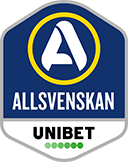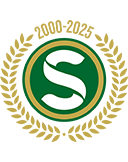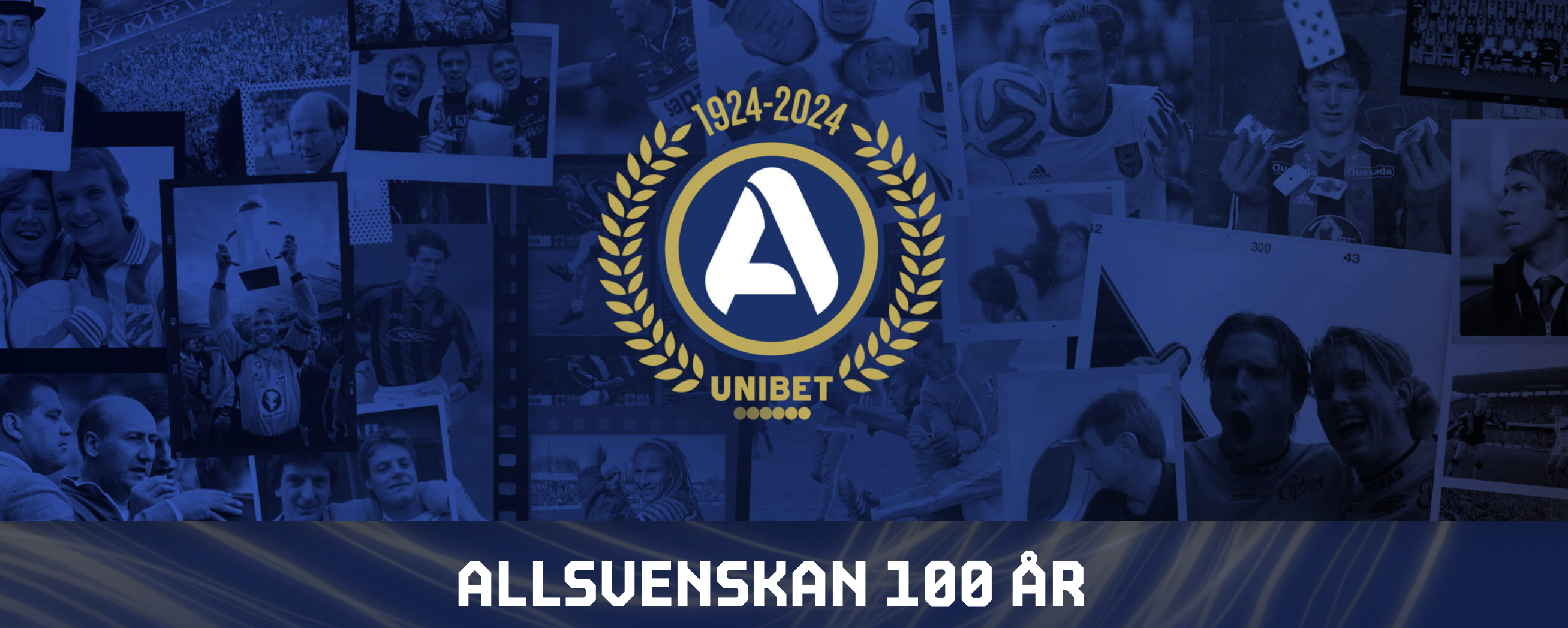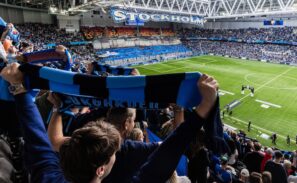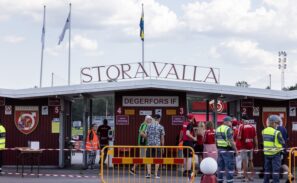On Saturday, August the 3rd, Sweden’s most beloved league, Allsvenskan, turns 100 years old. Since its inception in 1924, Allsvenskan has been a central part of Swedish society and a significant part of the lives of Swedes. Much has happened in Sweden over the past 100 years, but throughout it all, Allsvenskan has been there, filling many lives with joy, sorrow, and entertainment as the people’s movement that the league is.
Sweden in 1924: The sanitation workers in Sundsvall go on strike. Gösta Berling’s Saga premieres in theaters. The new tennis hall in Stockholm is inaugurated. The Malmö – Copenhagen flight route opens. The parliament introduces a gasoline tax of five öre per liter. The Grimeton radio station opens for commercial traffic. Allsvenskan in football starts, Sweden’s first nationwide football league played in a single division, with proper promotion and relegation.
The rest is history. For 100 years, Allsvenskan has developed in tandem with Swedish society. Social trends have crept into the stands, while football trends and styles have been reflected on the streets and squares.
The early years’ Allsvenskan champions came exclusively from Gothenburg. The last two years before the series gained championship status, Helsingborgs IF (then Hälsingborgs IF) won the title. In 1930, GAIS became the first to win Allsvenskan and simultaneously officially be awarded the Swedish Championship title.
Of the 67 clubs that have once played in Allsvenskan, 16 have won the Swedish Championship title. These are largely distributed between clubs in Sweden’s largest cities and/or cities with significant factories or industries. The textile cities of Norrköping and Borås, for instance, together have 20 Swedish Championships (IFK Norrköping, IK Sleipner, and IF Elfsborg). Åtvidabergs FF, with its Facit industry backing, has two Swedish Championships.
In the late 1950s, Allsvenskan experienced its biggest attendance boom so far, coinciding with the league’s switch from an autumn-spring schedule to a full calendar year with a spring-autumn format. Sweden had finished second in the 1958 World Cup on home soil, which also reflected in Allsvenskan. In 1959, the match between IFK Göteborg and Örgryte IS had 52,194 spectators at Ullevi in Gothenburg. This record still stands today as the largest attendance in Allsvenskan history. Örgryte IS also holds the record for the highest average attendance, with 22,486 spectators per match during that season, both home and away.
From 1982-1990, Allsvenskan was decided through a championship playoff after the season ended, and during the 1991 and 1992 seasons, a so-called Championship Series was played to crown the winner. Since 1993, the league has been played as we know it today, containing 16 clubs since 2008.
In today’s Sweden, Allsvenskan maintains a strong position in society. Over half of the population of ten million has a favorite team in the league. Most people live in the three largest cities, where the largest arenas are also found, but Allsvenskan remains strong throughout the country with many impressive attendance figures wherever you go. The Swedish elite football clubs and Allsvenskan are in a unique position where the league’s reach can connect with the people and influence in ways that authorities and politicians cannot. Not just in the stands but also outside match days and off the football field.
In fact, with each passing year, the importance of football grows, and with this, the clubs’ community engagement becomes more numerous and significant. In the report Fotbollsplanen mitt i byn (The Football Field in the Middle of the Village), economist Ingvar Nilsson states that the socioeconomic impact of elite clubs’ community efforts amounts to several billion kronor, and conservatively, elite football in Sweden is estimated to bring around SEK half a billion annually in direct revenue to the state treasury.
In 2024, Sweden is a different country than it was in 1924, but also exactly the same. The same goes for Allsvenskan as a league. Together, they have developed hand in hand, Sweden and Allsvenskan, and they will continue to do so in the future.
Towards 100 new years with Allsvenskan. Towards 100 new years with packed stands, song, joy, and genuine emotions. On and off the football field. Football. For real.
All 67 clubs who played in Allsvenskan 1924-2024:
| AIK |
| AFC Eskilstuna |
| Assyriska FF |
| Billingsfors IK |
| BK Derby |
| BK Häcken |
| Brynäs IF |
| Dalkurd FF |
| Degerfors IF |
| Djurgården |
| Enköpings SK |
| Falkenbergs FF |
| GAIS |
| Gefle IF |
| GIF Sundsvall |
| Gårda BK |
| Hallstahammars SK |
| Halmstads BK |
| Hammarby |
| Helsingborgs IF |
| Högadal IS |
| IF Brommapojkarna |
| IF Elfsborg |
| IFK Eskilstuna |
| IFK Göteborg |
| IFK Holmsund |
| IFK Luleå |
| IFK Malmö |
| IFK Norrköping |
| IFK Sundsvall |
| IFK Uddevalla |
| IFK Värnamo |
| IK Brage |
| IK City |
| IK Oddevold |
| IF Saab |
| IK Sirius |
| IK Sleipner |
| IS Halmia |
| Jönköpings Södra |
| Kalmar FF |
| Landskrona BoIS |
| Ljungskile SK |
| Ludvika FFI |
| Malmö FF |
| Mjällby AIF |
| Motala AIF |
| Norrby IF |
| Redbergslids IK |
| Reymersholm IK |
| Råå IF |
| Sandvikens AIK |
| Sandvikens IF |
| Stattena IF |
| Syrianska FC |
| Trelleborgs FF |
| Umeå FC |
| Varbergs BoIS |
| Västerås IK |
| Västerås SK |
| Västra Frölunda IF |
| Westermalms IF |
| Åtvidabergs FF |
| Örebro SK |
| Örgryte IS |
| Östers IF |
| Östersunds FK |
Most Allsvenskan titles:
Malmö FF: 23
IFK Göteborg: 15
IFK Norrköping: 13
Djurgården: 8
Helsingborgs IF/Hälsingsborgs IF: 7
AIK: 6
IF Elfsborg: 6
Halmstads BK: 4
Östers IF: 4
GAIS: 4
Örgryte IS: 3
Åtvidabergs FF: 2
IK Sleipner: 1
Hammarby: 1
Kalmar FF: 1
BK Häcken: 1
Allsvenskan winners 1924-2024:
1924/1925: GAIS
1925/1926: Örgryte IS
1926/1927: GAIS
1927/1928: Örgryte IS
1928/1929: Hälsingborgs IF
1929/1930: Hälsingborgs IF
1930/1931: GAIS (First year with official championship title)
1931/1932: AIK
1932/1933: Hälsingborgs IF
1933/1934: Hälsingborgs IF
1934/1935: IFK Göteborg
1935/1936: IF Elfsborg
1936/1937: AIK
1937/1938: IK Sleipner
1938/1939: IF Elfsborg
1939/1940: IF Elfsborg
1940/1941: Hälsingborgs IF
1941/1942: IFK Göteborg
1942/1943: IFK Norrköping
1943/1944: Malmö FF
1944/1945: IFK Norrköping
1945/1946: IFK Norrköping
1946/1947: IFK Norrköping
1947/1948: IFK Norrköping
1948/1949: Malmö FF
1949/1950: Malmö FF
1950/1951: Malmö FF
1951/1952: IFK Norrköping
1952/1953: Malmö FF
1953/1954: GAIS
1954/1955: Djurgårdens IF
1955/1956: IFK Norrköping
1956/1957: IFK Norrköping
1957/1958: IFK Göteborg (“The Marathon Allsvenskan”)
1959: Djurgårdens IF
1960: IFK Norrköping
1961: IF Elfsborg
1962: IFK Norrköping
1963: IFK Norrköping
1964: Djurgårdens IF
1965: Malmö FF
1966: Djurgårdens IF
1967: Malmö FF
1968: Östers IF
1969: IFK Göteborg
1970: Malmö FF
1971: Malmö FF
1972: Åtvidabergs FF
1973: Åtvidabergs FF
1974: Malmö FF
1975: Malmö FF
1976: Halmstads BK
1977: Malmö FF
1978: Östers IF
1979: Halmstads BK
1980: Östers IF
1981: Östers IF
1982: IFK Göteborg (After playoffs)
1983: IFK Göteborg (After playoffs)
1984: IFK Göteborg (After playoffs)
1985: Örgryte IS (After playoffs)
1986: Malmö FF (After playoffs)
1987: IFK Göteborg (After playoffs)
1988: Malmö FF (After playoffs)
1989: IFK Norrköping (After playoffs)
1990: IFK Göteborg (After playoffs)
1991: IFK Göteborg (After championship series)
1992: AIK (fter championship series)
1993: IFK Göteborg
1994: IFK Göteborg
1995: IFK Göteborg
1996: IFK Göteborg
1997: Halmstads BK
1998: AIK
1999: Helsingborgs IF
2000: Halmstads BK
2001: Hammarby IF
2002: Djurgårdens IF
2003: Djurgårdens IF
2004: Malmö FF
2005: Djurgårdens IF
2006: IF Elfsborg
2007: IFK Göteborg
2008: Kalmar FF
2009: AIK
2010: Malmö FF
2011: Helsingborgs IF
2012: IF Elfsborg
2013: Malmö FF
2014: Malmö FF
2015: IFK Norrköping
2016: Malmö FF
2017: Malmö FF
2018: AIK
2019: Djurgårdens IF
2020: Malmö FF
2021: Malmö FF
2022: BK Häcken
2023: Malmö FF
2024: ?

